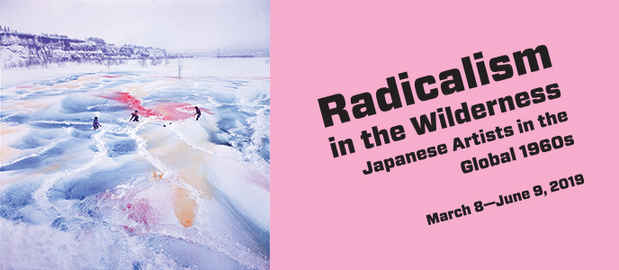“Radicalism in the Wilderness” Exhibition
The FLAG Art Foundation

This event has ended.
Delve into the radical experiments of artists from 1960s Japan who made groundbreaking contributions to the development of international postwar art in defiance of existing conventions. Little known in the U.S., artist Yutaka Matsuzawa and the two collectives The Play and GUN challenged established norms to expand the definition of visual art through language, performance, mail art, land art, and political art. Radicalism in the Wilderness surveys the range of their projects, at times colorful, imaginative, and playful, but also inextricably linked to complex social, political, and cultural issues of the turbulent and innovative 1960s.
YUTAKA MATSUZAWA
Hailing from Shimo Suwa in mountainous central Japan, Matsuzawa was one of Japan’s pioneer conceptual artists. He made a complete break from materiality in his art through his drastic proposal of “vanishing of matter,” best exemplified in his landmark exhibition Independent ’64 in the Wilderness (1964). The exhibition completely eliminated the physical presence of artworks, instead showcasing “formless emissions” by himself and other artists. Informed by his interests in contemporary science, parapsychology, and non-Zen Buddhism, Matsuzawa established his immaterial art using “kannen,” a Buddhist-derived practice of “meditative visualization” to unleash the viewer’s mental faculty to see the mind’s eye. Using the principle of vanishing of matter and the method of kannen, he formulated Non-Sensory Painting, an attempt to make the invisible visible through a theoretical construct akin to astrophysics and quantum mechanics.
GUN
Composed of artists from the northern Niigata prefecture facing the Sea of Japan, this collective was best known for their ephemeral and site-specific experience of Event to Change the Image of Snow (1970), which included the group members spraying an array of bright color pigments over the isolated, snow-covered dry riverbed of the Shinano River. GUN reprised the act four days later, and each event lasted only 30 minutes, as new snowfall quickly erased the huge color field abstraction. A GUN member, Horikawa Michio, also pioneered mail art with the Mail Art by Sending Stones series. For the series, Michio responded to the moon landing in 1969 by mailing 11 stones gathered along the Shinano River, critically echoing the Apollo mission to collect moon rocks for scientific research, as a way of turning human attention to the tumultuous Earth.
THE PLAY
An Osaka-based collective of “Happeners”, The Play created a series of “voyages” into various landscapes—oceans, rivers, mountains. The group formulated their voyages as their annual summer project, from 1968 through 1986, beginning with the launching of a giant fiberglass egg into the Pacific Ocean off the southernmost tip of Japan’s main island. Voyage: Happening in an Egg (1968) was described as an “image of liberation from all the material and mental restrictions imposed upon us who live in contemporary times.” By collaborating with ordinary people who provided them with the necessary resources for these landscape-based projects, they prefigured the contemporary movement for community-based, socially engaged art practices.
Media
Schedule
from March 08, 2019 to June 08, 2019